Cyber Safety and Bullying Prevention Programs
VerifiedAdded on 2023/01/12
|10
|2798
|20
AI Summary
This article discusses the importance of addressing bullying and its impact on mental health in adolescents. It explores different programs and initiatives, such as the Victorian anti-bullying and mental health initiative, the program implemented by Anti-Bullying Alliance in the UK, Bully Zero's Cyber Safety and Bullying Prevention Programs, and the Friendly Schools initiative in Australia. These programs aim to reduce bullying, empower victims, and improve mental health outcomes for adolescents.
Contribute Materials
Your contribution can guide someone’s learning journey. Share your
documents today.

Running head: PORTFOLIO
Portfolio
Name of the student:
Name of the University:
Author’s note
Portfolio
Name of the student:
Name of the University:
Author’s note
Secure Best Marks with AI Grader
Need help grading? Try our AI Grader for instant feedback on your assignments.
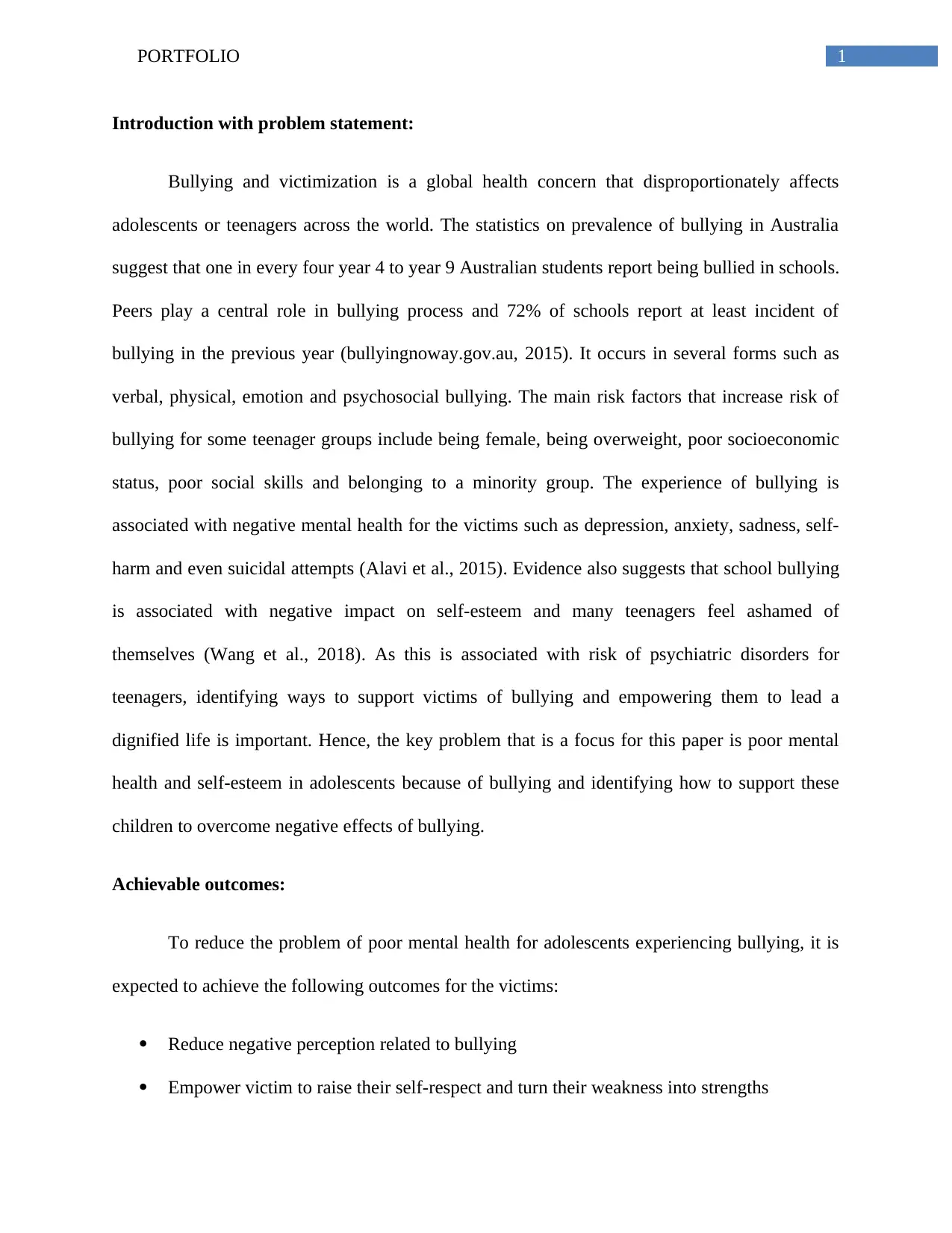
1PORTFOLIO
Introduction with problem statement:
Bullying and victimization is a global health concern that disproportionately affects
adolescents or teenagers across the world. The statistics on prevalence of bullying in Australia
suggest that one in every four year 4 to year 9 Australian students report being bullied in schools.
Peers play a central role in bullying process and 72% of schools report at least incident of
bullying in the previous year (bullyingnoway.gov.au, 2015). It occurs in several forms such as
verbal, physical, emotion and psychosocial bullying. The main risk factors that increase risk of
bullying for some teenager groups include being female, being overweight, poor socioeconomic
status, poor social skills and belonging to a minority group. The experience of bullying is
associated with negative mental health for the victims such as depression, anxiety, sadness, self-
harm and even suicidal attempts (Alavi et al., 2015). Evidence also suggests that school bullying
is associated with negative impact on self-esteem and many teenagers feel ashamed of
themselves (Wang et al., 2018). As this is associated with risk of psychiatric disorders for
teenagers, identifying ways to support victims of bullying and empowering them to lead a
dignified life is important. Hence, the key problem that is a focus for this paper is poor mental
health and self-esteem in adolescents because of bullying and identifying how to support these
children to overcome negative effects of bullying.
Achievable outcomes:
To reduce the problem of poor mental health for adolescents experiencing bullying, it is
expected to achieve the following outcomes for the victims:
Reduce negative perception related to bullying
Empower victim to raise their self-respect and turn their weakness into strengths
Introduction with problem statement:
Bullying and victimization is a global health concern that disproportionately affects
adolescents or teenagers across the world. The statistics on prevalence of bullying in Australia
suggest that one in every four year 4 to year 9 Australian students report being bullied in schools.
Peers play a central role in bullying process and 72% of schools report at least incident of
bullying in the previous year (bullyingnoway.gov.au, 2015). It occurs in several forms such as
verbal, physical, emotion and psychosocial bullying. The main risk factors that increase risk of
bullying for some teenager groups include being female, being overweight, poor socioeconomic
status, poor social skills and belonging to a minority group. The experience of bullying is
associated with negative mental health for the victims such as depression, anxiety, sadness, self-
harm and even suicidal attempts (Alavi et al., 2015). Evidence also suggests that school bullying
is associated with negative impact on self-esteem and many teenagers feel ashamed of
themselves (Wang et al., 2018). As this is associated with risk of psychiatric disorders for
teenagers, identifying ways to support victims of bullying and empowering them to lead a
dignified life is important. Hence, the key problem that is a focus for this paper is poor mental
health and self-esteem in adolescents because of bullying and identifying how to support these
children to overcome negative effects of bullying.
Achievable outcomes:
To reduce the problem of poor mental health for adolescents experiencing bullying, it is
expected to achieve the following outcomes for the victims:
Reduce negative perception related to bullying
Empower victim to raise their self-respect and turn their weakness into strengths
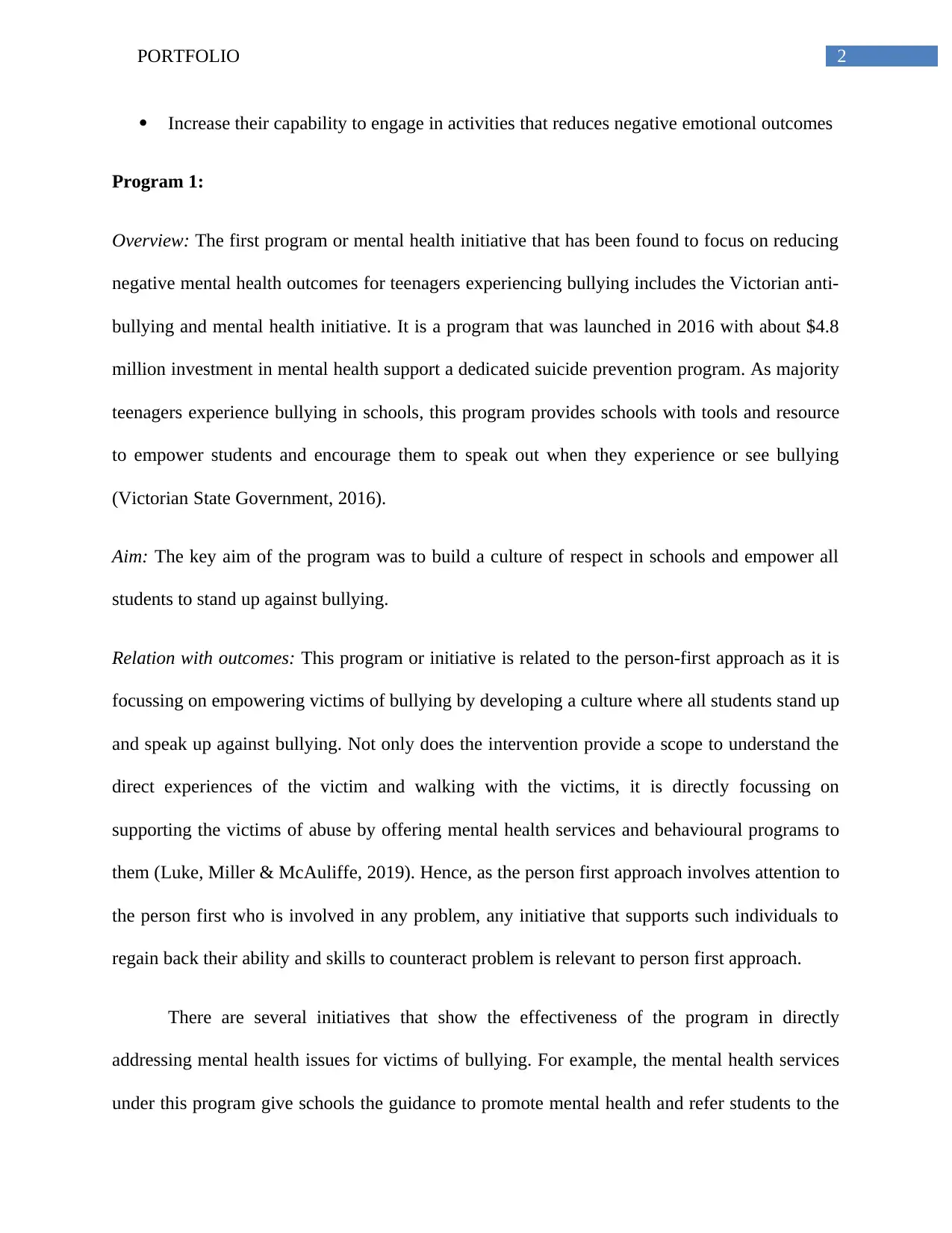
2PORTFOLIO
Increase their capability to engage in activities that reduces negative emotional outcomes
Program 1:
Overview: The first program or mental health initiative that has been found to focus on reducing
negative mental health outcomes for teenagers experiencing bullying includes the Victorian anti-
bullying and mental health initiative. It is a program that was launched in 2016 with about $4.8
million investment in mental health support a dedicated suicide prevention program. As majority
teenagers experience bullying in schools, this program provides schools with tools and resource
to empower students and encourage them to speak out when they experience or see bullying
(Victorian State Government, 2016).
Aim: The key aim of the program was to build a culture of respect in schools and empower all
students to stand up against bullying.
Relation with outcomes: This program or initiative is related to the person-first approach as it is
focussing on empowering victims of bullying by developing a culture where all students stand up
and speak up against bullying. Not only does the intervention provide a scope to understand the
direct experiences of the victim and walking with the victims, it is directly focussing on
supporting the victims of abuse by offering mental health services and behavioural programs to
them (Luke, Miller & McAuliffe, 2019). Hence, as the person first approach involves attention to
the person first who is involved in any problem, any initiative that supports such individuals to
regain back their ability and skills to counteract problem is relevant to person first approach.
There are several initiatives that show the effectiveness of the program in directly
addressing mental health issues for victims of bullying. For example, the mental health services
under this program give schools the guidance to promote mental health and refer students to the
Increase their capability to engage in activities that reduces negative emotional outcomes
Program 1:
Overview: The first program or mental health initiative that has been found to focus on reducing
negative mental health outcomes for teenagers experiencing bullying includes the Victorian anti-
bullying and mental health initiative. It is a program that was launched in 2016 with about $4.8
million investment in mental health support a dedicated suicide prevention program. As majority
teenagers experience bullying in schools, this program provides schools with tools and resource
to empower students and encourage them to speak out when they experience or see bullying
(Victorian State Government, 2016).
Aim: The key aim of the program was to build a culture of respect in schools and empower all
students to stand up against bullying.
Relation with outcomes: This program or initiative is related to the person-first approach as it is
focussing on empowering victims of bullying by developing a culture where all students stand up
and speak up against bullying. Not only does the intervention provide a scope to understand the
direct experiences of the victim and walking with the victims, it is directly focussing on
supporting the victims of abuse by offering mental health services and behavioural programs to
them (Luke, Miller & McAuliffe, 2019). Hence, as the person first approach involves attention to
the person first who is involved in any problem, any initiative that supports such individuals to
regain back their ability and skills to counteract problem is relevant to person first approach.
There are several initiatives that show the effectiveness of the program in directly
addressing mental health issues for victims of bullying. For example, the mental health services
under this program give schools the guidance to promote mental health and refer students to the
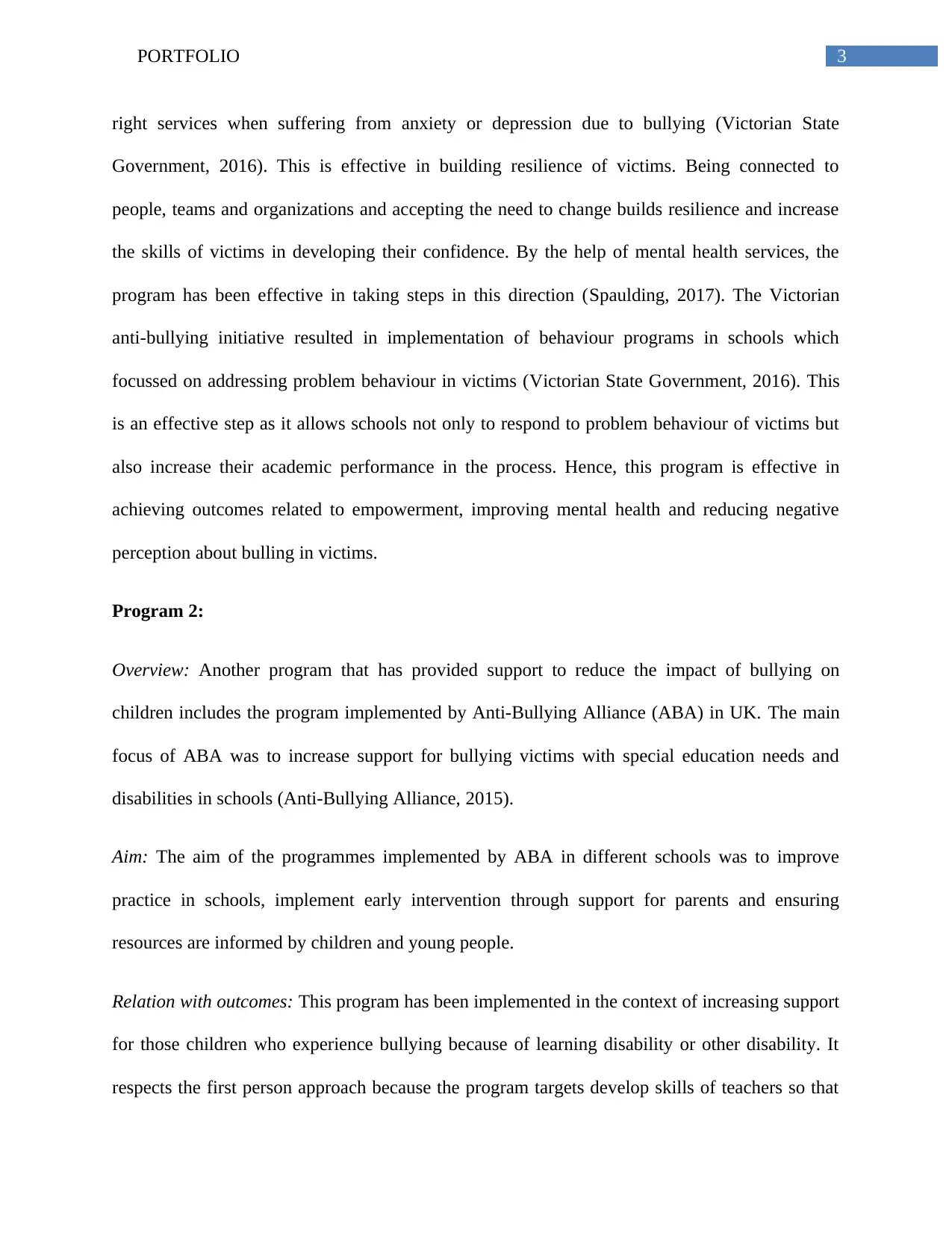
3PORTFOLIO
right services when suffering from anxiety or depression due to bullying (Victorian State
Government, 2016). This is effective in building resilience of victims. Being connected to
people, teams and organizations and accepting the need to change builds resilience and increase
the skills of victims in developing their confidence. By the help of mental health services, the
program has been effective in taking steps in this direction (Spaulding, 2017). The Victorian
anti-bullying initiative resulted in implementation of behaviour programs in schools which
focussed on addressing problem behaviour in victims (Victorian State Government, 2016). This
is an effective step as it allows schools not only to respond to problem behaviour of victims but
also increase their academic performance in the process. Hence, this program is effective in
achieving outcomes related to empowerment, improving mental health and reducing negative
perception about bulling in victims.
Program 2:
Overview: Another program that has provided support to reduce the impact of bullying on
children includes the program implemented by Anti-Bullying Alliance (ABA) in UK. The main
focus of ABA was to increase support for bullying victims with special education needs and
disabilities in schools (Anti-Bullying Alliance, 2015).
Aim: The aim of the programmes implemented by ABA in different schools was to improve
practice in schools, implement early intervention through support for parents and ensuring
resources are informed by children and young people.
Relation with outcomes: This program has been implemented in the context of increasing support
for those children who experience bullying because of learning disability or other disability. It
respects the first person approach because the program targets develop skills of teachers so that
right services when suffering from anxiety or depression due to bullying (Victorian State
Government, 2016). This is effective in building resilience of victims. Being connected to
people, teams and organizations and accepting the need to change builds resilience and increase
the skills of victims in developing their confidence. By the help of mental health services, the
program has been effective in taking steps in this direction (Spaulding, 2017). The Victorian
anti-bullying initiative resulted in implementation of behaviour programs in schools which
focussed on addressing problem behaviour in victims (Victorian State Government, 2016). This
is an effective step as it allows schools not only to respond to problem behaviour of victims but
also increase their academic performance in the process. Hence, this program is effective in
achieving outcomes related to empowerment, improving mental health and reducing negative
perception about bulling in victims.
Program 2:
Overview: Another program that has provided support to reduce the impact of bullying on
children includes the program implemented by Anti-Bullying Alliance (ABA) in UK. The main
focus of ABA was to increase support for bullying victims with special education needs and
disabilities in schools (Anti-Bullying Alliance, 2015).
Aim: The aim of the programmes implemented by ABA in different schools was to improve
practice in schools, implement early intervention through support for parents and ensuring
resources are informed by children and young people.
Relation with outcomes: This program has been implemented in the context of increasing support
for those children who experience bullying because of learning disability or other disability. It
respects the first person approach because the program targets develop skills of teachers so that
Secure Best Marks with AI Grader
Need help grading? Try our AI Grader for instant feedback on your assignments.
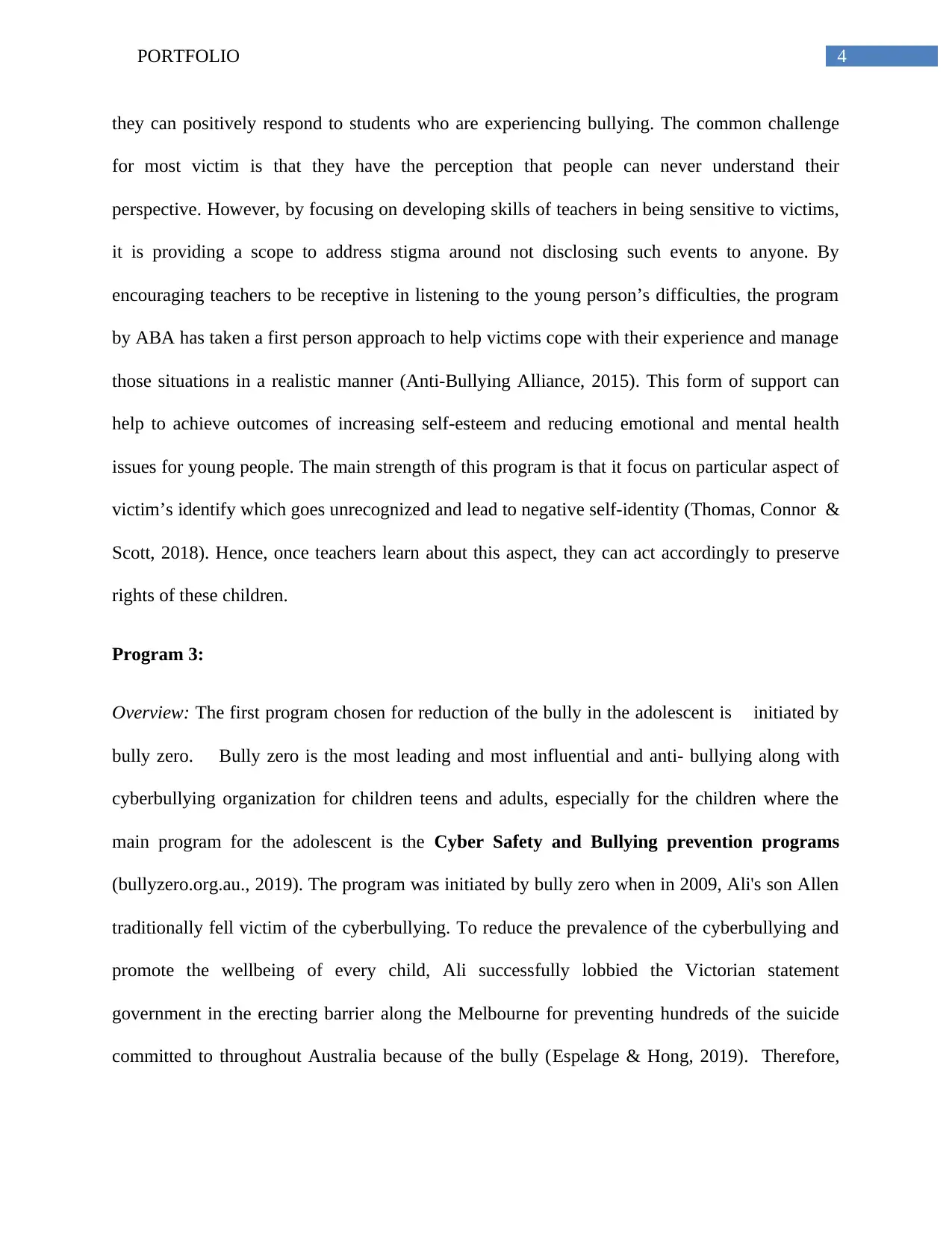
4PORTFOLIO
they can positively respond to students who are experiencing bullying. The common challenge
for most victim is that they have the perception that people can never understand their
perspective. However, by focusing on developing skills of teachers in being sensitive to victims,
it is providing a scope to address stigma around not disclosing such events to anyone. By
encouraging teachers to be receptive in listening to the young person’s difficulties, the program
by ABA has taken a first person approach to help victims cope with their experience and manage
those situations in a realistic manner (Anti-Bullying Alliance, 2015). This form of support can
help to achieve outcomes of increasing self-esteem and reducing emotional and mental health
issues for young people. The main strength of this program is that it focus on particular aspect of
victim’s identify which goes unrecognized and lead to negative self-identity (Thomas, Connor &
Scott, 2018). Hence, once teachers learn about this aspect, they can act accordingly to preserve
rights of these children.
Program 3:
Overview: The first program chosen for reduction of the bully in the adolescent is initiated by
bully zero. Bully zero is the most leading and most influential and anti- bullying along with
cyberbullying organization for children teens and adults, especially for the children where the
main program for the adolescent is the Cyber Safety and Bullying prevention programs
(bullyzero.org.au., 2019). The program was initiated by bully zero when in 2009, Ali's son Allen
traditionally fell victim of the cyberbullying. To reduce the prevalence of the cyberbullying and
promote the wellbeing of every child, Ali successfully lobbied the Victorian statement
government in the erecting barrier along the Melbourne for preventing hundreds of the suicide
committed to throughout Australia because of the bully (Espelage & Hong, 2019). Therefore,
they can positively respond to students who are experiencing bullying. The common challenge
for most victim is that they have the perception that people can never understand their
perspective. However, by focusing on developing skills of teachers in being sensitive to victims,
it is providing a scope to address stigma around not disclosing such events to anyone. By
encouraging teachers to be receptive in listening to the young person’s difficulties, the program
by ABA has taken a first person approach to help victims cope with their experience and manage
those situations in a realistic manner (Anti-Bullying Alliance, 2015). This form of support can
help to achieve outcomes of increasing self-esteem and reducing emotional and mental health
issues for young people. The main strength of this program is that it focus on particular aspect of
victim’s identify which goes unrecognized and lead to negative self-identity (Thomas, Connor &
Scott, 2018). Hence, once teachers learn about this aspect, they can act accordingly to preserve
rights of these children.
Program 3:
Overview: The first program chosen for reduction of the bully in the adolescent is initiated by
bully zero. Bully zero is the most leading and most influential and anti- bullying along with
cyberbullying organization for children teens and adults, especially for the children where the
main program for the adolescent is the Cyber Safety and Bullying prevention programs
(bullyzero.org.au., 2019). The program was initiated by bully zero when in 2009, Ali's son Allen
traditionally fell victim of the cyberbullying. To reduce the prevalence of the cyberbullying and
promote the wellbeing of every child, Ali successfully lobbied the Victorian statement
government in the erecting barrier along the Melbourne for preventing hundreds of the suicide
committed to throughout Australia because of the bully (Espelage & Hong, 2019). Therefore,

5PORTFOLIO
the program was designed to reduce suicide in children throughout Australia, especially in the
adolescences in Australia.
Aim: The program was intended to reduce and prevent the bullying by creating an environment
where every victim who experienced bully feels safe, comfortable and empowered through the
program. As discussed by Turcotte et al. (2015), the victims of the bully, especially cyberbully
is exposed to the high level of the emotional distress which affected their mental wellbeing and
disrupt the normal life.
Relationship of the outcome: The primary achievable outcome of the portfolio was to improve
the mental health of the victims who are exposed to the bully through providing educations,
creating the environment or the victims, reducing the negative perception of bullying so that
they feel safe, empower and confident and engage themselves in the normal activity(Espelage &
Hong, 2019) . The Cyber Safety and Bullying prevention program took the initiatives to reduce
the cyberbully in approximately 1000 schools by involving parents of the victims, victims and
other members of the community to reduce the cyberbullying where they use privacy policy used
(Toseeb, McChesney & Wolke, 2018). The Cyber Safety and Bullying prevention program
adopted a holistic approach and educating the school community students, teachers and parents
of the victim to create a safe environment of the victim. The program generally presented as a
lecture or workshop depending on the participants who are willing to participate in the program.
The volunteers of the program use first person face to face approach to meet the need of the
individuals by prioritizing each individual and their concerns. The program covers the
classification of the bully that observed in the Australia, current statistics of bullying along with
the number of mentally ill patient because of the cyberbully, the role of the bystander, strategies
to responded to the poor behaviour of the person involved in bullying and participants who are
the program was designed to reduce suicide in children throughout Australia, especially in the
adolescences in Australia.
Aim: The program was intended to reduce and prevent the bullying by creating an environment
where every victim who experienced bully feels safe, comfortable and empowered through the
program. As discussed by Turcotte et al. (2015), the victims of the bully, especially cyberbully
is exposed to the high level of the emotional distress which affected their mental wellbeing and
disrupt the normal life.
Relationship of the outcome: The primary achievable outcome of the portfolio was to improve
the mental health of the victims who are exposed to the bully through providing educations,
creating the environment or the victims, reducing the negative perception of bullying so that
they feel safe, empower and confident and engage themselves in the normal activity(Espelage &
Hong, 2019) . The Cyber Safety and Bullying prevention program took the initiatives to reduce
the cyberbully in approximately 1000 schools by involving parents of the victims, victims and
other members of the community to reduce the cyberbullying where they use privacy policy used
(Toseeb, McChesney & Wolke, 2018). The Cyber Safety and Bullying prevention program
adopted a holistic approach and educating the school community students, teachers and parents
of the victim to create a safe environment of the victim. The program generally presented as a
lecture or workshop depending on the participants who are willing to participate in the program.
The volunteers of the program use first person face to face approach to meet the need of the
individuals by prioritizing each individual and their concerns. The program covers the
classification of the bully that observed in the Australia, current statistics of bullying along with
the number of mentally ill patient because of the cyberbully, the role of the bystander, strategies
to responded to the poor behaviour of the person involved in bullying and participants who are

6PORTFOLIO
participant are providing with empathy respect an hope along with where to seek help. The
program successfully reduced more than thousand suicides in the past six years.
Program 4:
Overview: In Australia, friendly School is the first anti-bullying initiative for the schools,
especially the children, the adolescent of the school through extensive research with the
Australian children and adolescents (friendlyschools.com.au., 2019). It is recognized as
nationally and internationally as an evidence-based and comprehensive holistic approach which
can reduce the bullying behaviour of children. As discussed by Turcotte et al. (2015), the
friendly School initiatives were taken based to improve the wellbeing of the children which is
aligned with the Australian curriculum and national safe school program. The friendly school
initiatives help a school, communities to build their own capacity for change. Therefore, the
program involves children, and teachers to promote the emotional wellbeing of the children. As
discussed by Toseeb, McChesney and Wolke (2018), the program enables schools to assess
the social and emotional wellbeing of their students, evaluating their existing strategies to the
bully prevention and recognize the areas which require the improvement and then address the
gap using widely tested strategies. The program also uses leadership commitment to a safe
school where the volunteers not only focused on the victim of the bully but also the children who
may have the tendency of involving in the act of bully because of the peer pressure. The primary
reason behind it is that, as discussed by Jia and Mikami, (2015), the act of the bully is also a sign
of ill mental health. Therefore, in the current context, it is crucial to assessing the mental health
of the children who involve themselves in bullying to prevent the act of bullying.
participant are providing with empathy respect an hope along with where to seek help. The
program successfully reduced more than thousand suicides in the past six years.
Program 4:
Overview: In Australia, friendly School is the first anti-bullying initiative for the schools,
especially the children, the adolescent of the school through extensive research with the
Australian children and adolescents (friendlyschools.com.au., 2019). It is recognized as
nationally and internationally as an evidence-based and comprehensive holistic approach which
can reduce the bullying behaviour of children. As discussed by Turcotte et al. (2015), the
friendly School initiatives were taken based to improve the wellbeing of the children which is
aligned with the Australian curriculum and national safe school program. The friendly school
initiatives help a school, communities to build their own capacity for change. Therefore, the
program involves children, and teachers to promote the emotional wellbeing of the children. As
discussed by Toseeb, McChesney and Wolke (2018), the program enables schools to assess
the social and emotional wellbeing of their students, evaluating their existing strategies to the
bully prevention and recognize the areas which require the improvement and then address the
gap using widely tested strategies. The program also uses leadership commitment to a safe
school where the volunteers not only focused on the victim of the bully but also the children who
may have the tendency of involving in the act of bully because of the peer pressure. The primary
reason behind it is that, as discussed by Jia and Mikami, (2015), the act of the bully is also a sign
of ill mental health. Therefore, in the current context, it is crucial to assessing the mental health
of the children who involve themselves in bullying to prevent the act of bullying.
Paraphrase This Document
Need a fresh take? Get an instant paraphrase of this document with our AI Paraphraser
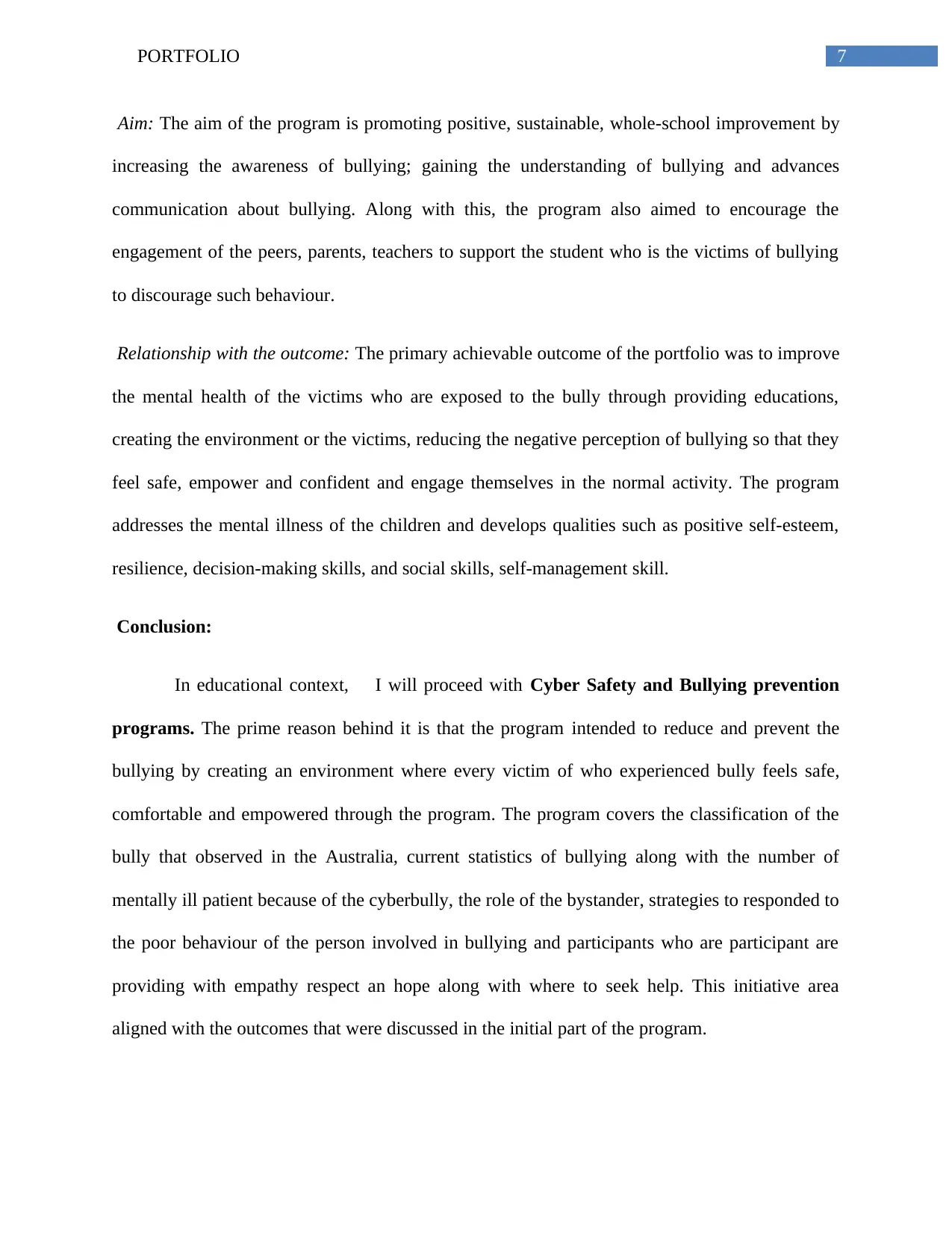
7PORTFOLIO
Aim: The aim of the program is promoting positive, sustainable, whole-school improvement by
increasing the awareness of bullying; gaining the understanding of bullying and advances
communication about bullying. Along with this, the program also aimed to encourage the
engagement of the peers, parents, teachers to support the student who is the victims of bullying
to discourage such behaviour.
Relationship with the outcome: The primary achievable outcome of the portfolio was to improve
the mental health of the victims who are exposed to the bully through providing educations,
creating the environment or the victims, reducing the negative perception of bullying so that they
feel safe, empower and confident and engage themselves in the normal activity. The program
addresses the mental illness of the children and develops qualities such as positive self-esteem,
resilience, decision-making skills, and social skills, self-management skill.
Conclusion:
In educational context, I will proceed with Cyber Safety and Bullying prevention
programs. The prime reason behind it is that the program intended to reduce and prevent the
bullying by creating an environment where every victim of who experienced bully feels safe,
comfortable and empowered through the program. The program covers the classification of the
bully that observed in the Australia, current statistics of bullying along with the number of
mentally ill patient because of the cyberbully, the role of the bystander, strategies to responded to
the poor behaviour of the person involved in bullying and participants who are participant are
providing with empathy respect an hope along with where to seek help. This initiative area
aligned with the outcomes that were discussed in the initial part of the program.
Aim: The aim of the program is promoting positive, sustainable, whole-school improvement by
increasing the awareness of bullying; gaining the understanding of bullying and advances
communication about bullying. Along with this, the program also aimed to encourage the
engagement of the peers, parents, teachers to support the student who is the victims of bullying
to discourage such behaviour.
Relationship with the outcome: The primary achievable outcome of the portfolio was to improve
the mental health of the victims who are exposed to the bully through providing educations,
creating the environment or the victims, reducing the negative perception of bullying so that they
feel safe, empower and confident and engage themselves in the normal activity. The program
addresses the mental illness of the children and develops qualities such as positive self-esteem,
resilience, decision-making skills, and social skills, self-management skill.
Conclusion:
In educational context, I will proceed with Cyber Safety and Bullying prevention
programs. The prime reason behind it is that the program intended to reduce and prevent the
bullying by creating an environment where every victim of who experienced bully feels safe,
comfortable and empowered through the program. The program covers the classification of the
bully that observed in the Australia, current statistics of bullying along with the number of
mentally ill patient because of the cyberbully, the role of the bystander, strategies to responded to
the poor behaviour of the person involved in bullying and participants who are participant are
providing with empathy respect an hope along with where to seek help. This initiative area
aligned with the outcomes that were discussed in the initial part of the program.
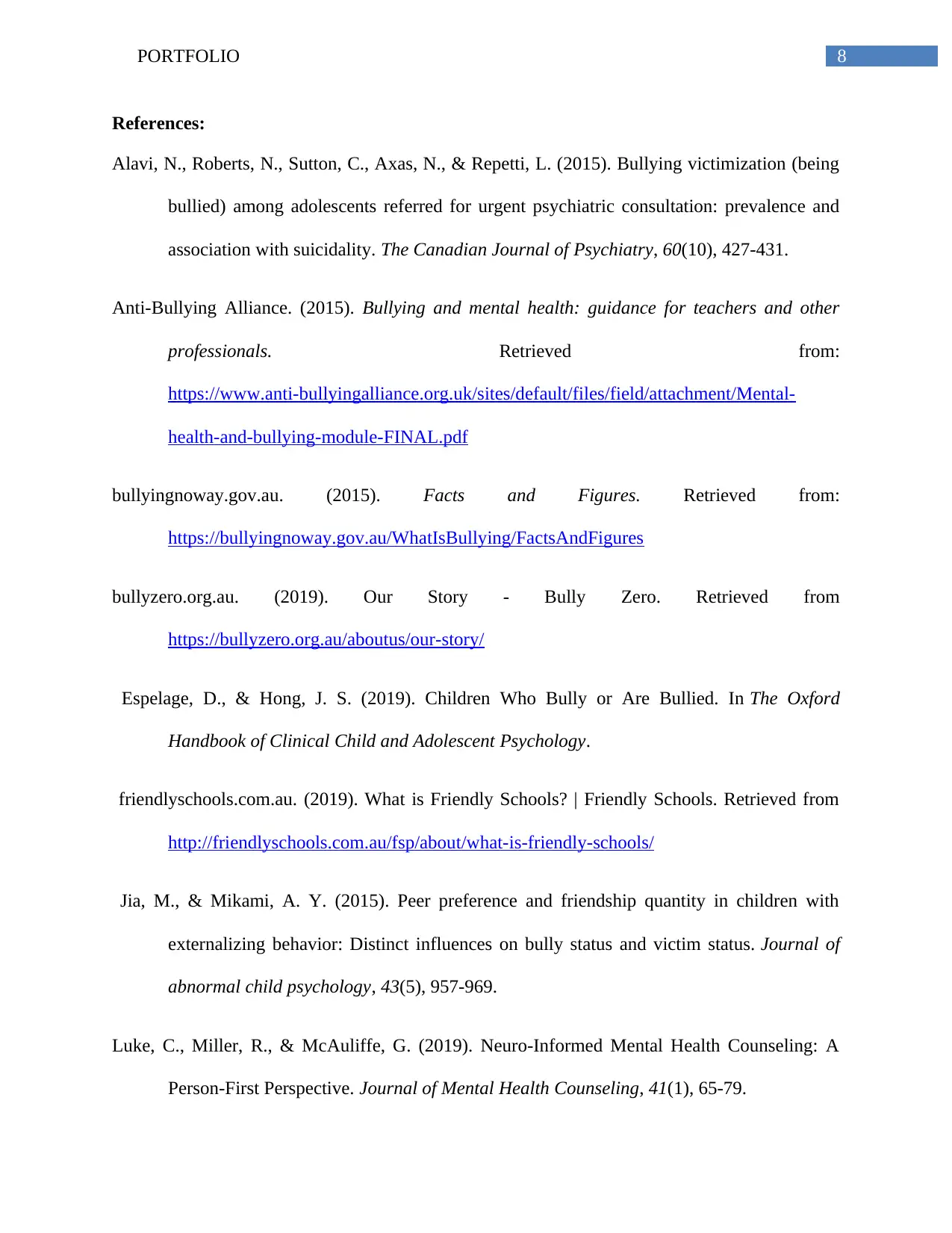
8PORTFOLIO
References:
Alavi, N., Roberts, N., Sutton, C., Axas, N., & Repetti, L. (2015). Bullying victimization (being
bullied) among adolescents referred for urgent psychiatric consultation: prevalence and
association with suicidality. The Canadian Journal of Psychiatry, 60(10), 427-431.
Anti-Bullying Alliance. (2015). Bullying and mental health: guidance for teachers and other
professionals. Retrieved from:
https://www.anti-bullyingalliance.org.uk/sites/default/files/field/attachment/Mental-
health-and-bullying-module-FINAL.pdf
bullyingnoway.gov.au. (2015). Facts and Figures. Retrieved from:
https://bullyingnoway.gov.au/WhatIsBullying/FactsAndFigures
bullyzero.org.au. (2019). Our Story - Bully Zero. Retrieved from
https://bullyzero.org.au/aboutus/our-story/
Espelage, D., & Hong, J. S. (2019). Children Who Bully or Are Bullied. In The Oxford
Handbook of Clinical Child and Adolescent Psychology.
friendlyschools.com.au. (2019). What is Friendly Schools? | Friendly Schools. Retrieved from
http://friendlyschools.com.au/fsp/about/what-is-friendly-schools/
Jia, M., & Mikami, A. Y. (2015). Peer preference and friendship quantity in children with
externalizing behavior: Distinct influences on bully status and victim status. Journal of
abnormal child psychology, 43(5), 957-969.
Luke, C., Miller, R., & McAuliffe, G. (2019). Neuro-Informed Mental Health Counseling: A
Person-First Perspective. Journal of Mental Health Counseling, 41(1), 65-79.
References:
Alavi, N., Roberts, N., Sutton, C., Axas, N., & Repetti, L. (2015). Bullying victimization (being
bullied) among adolescents referred for urgent psychiatric consultation: prevalence and
association with suicidality. The Canadian Journal of Psychiatry, 60(10), 427-431.
Anti-Bullying Alliance. (2015). Bullying and mental health: guidance for teachers and other
professionals. Retrieved from:
https://www.anti-bullyingalliance.org.uk/sites/default/files/field/attachment/Mental-
health-and-bullying-module-FINAL.pdf
bullyingnoway.gov.au. (2015). Facts and Figures. Retrieved from:
https://bullyingnoway.gov.au/WhatIsBullying/FactsAndFigures
bullyzero.org.au. (2019). Our Story - Bully Zero. Retrieved from
https://bullyzero.org.au/aboutus/our-story/
Espelage, D., & Hong, J. S. (2019). Children Who Bully or Are Bullied. In The Oxford
Handbook of Clinical Child and Adolescent Psychology.
friendlyschools.com.au. (2019). What is Friendly Schools? | Friendly Schools. Retrieved from
http://friendlyschools.com.au/fsp/about/what-is-friendly-schools/
Jia, M., & Mikami, A. Y. (2015). Peer preference and friendship quantity in children with
externalizing behavior: Distinct influences on bully status and victim status. Journal of
abnormal child psychology, 43(5), 957-969.
Luke, C., Miller, R., & McAuliffe, G. (2019). Neuro-Informed Mental Health Counseling: A
Person-First Perspective. Journal of Mental Health Counseling, 41(1), 65-79.
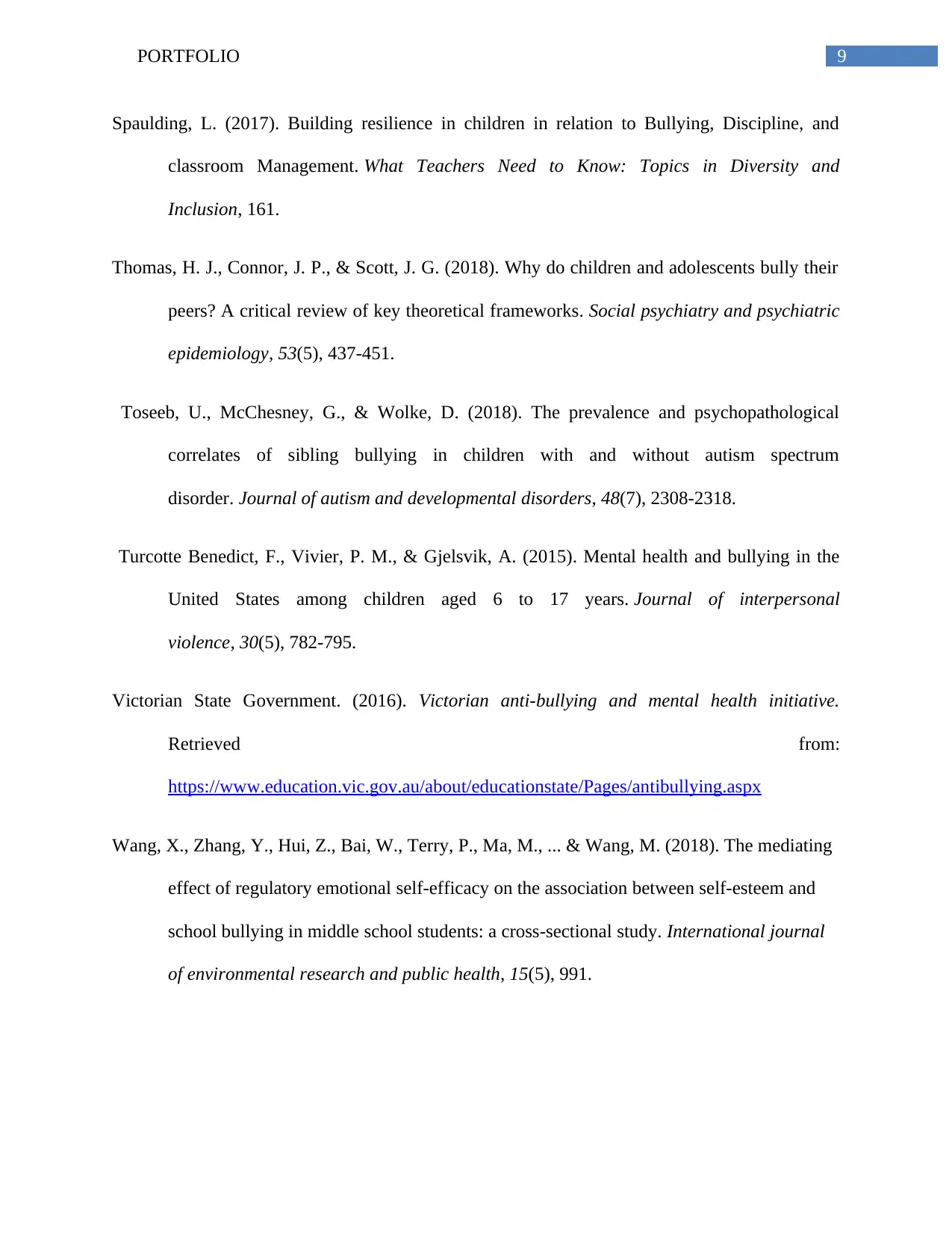
9PORTFOLIO
Spaulding, L. (2017). Building resilience in children in relation to Bullying, Discipline, and
classroom Management. What Teachers Need to Know: Topics in Diversity and
Inclusion, 161.
Thomas, H. J., Connor, J. P., & Scott, J. G. (2018). Why do children and adolescents bully their
peers? A critical review of key theoretical frameworks. Social psychiatry and psychiatric
epidemiology, 53(5), 437-451.
Toseeb, U., McChesney, G., & Wolke, D. (2018). The prevalence and psychopathological
correlates of sibling bullying in children with and without autism spectrum
disorder. Journal of autism and developmental disorders, 48(7), 2308-2318.
Turcotte Benedict, F., Vivier, P. M., & Gjelsvik, A. (2015). Mental health and bullying in the
United States among children aged 6 to 17 years. Journal of interpersonal
violence, 30(5), 782-795.
Victorian State Government. (2016). Victorian anti-bullying and mental health initiative.
Retrieved from:
https://www.education.vic.gov.au/about/educationstate/Pages/antibullying.aspx
Wang, X., Zhang, Y., Hui, Z., Bai, W., Terry, P., Ma, M., ... & Wang, M. (2018). The mediating
effect of regulatory emotional self-efficacy on the association between self-esteem and
school bullying in middle school students: a cross-sectional study. International journal
of environmental research and public health, 15(5), 991.
Spaulding, L. (2017). Building resilience in children in relation to Bullying, Discipline, and
classroom Management. What Teachers Need to Know: Topics in Diversity and
Inclusion, 161.
Thomas, H. J., Connor, J. P., & Scott, J. G. (2018). Why do children and adolescents bully their
peers? A critical review of key theoretical frameworks. Social psychiatry and psychiatric
epidemiology, 53(5), 437-451.
Toseeb, U., McChesney, G., & Wolke, D. (2018). The prevalence and psychopathological
correlates of sibling bullying in children with and without autism spectrum
disorder. Journal of autism and developmental disorders, 48(7), 2308-2318.
Turcotte Benedict, F., Vivier, P. M., & Gjelsvik, A. (2015). Mental health and bullying in the
United States among children aged 6 to 17 years. Journal of interpersonal
violence, 30(5), 782-795.
Victorian State Government. (2016). Victorian anti-bullying and mental health initiative.
Retrieved from:
https://www.education.vic.gov.au/about/educationstate/Pages/antibullying.aspx
Wang, X., Zhang, Y., Hui, Z., Bai, W., Terry, P., Ma, M., ... & Wang, M. (2018). The mediating
effect of regulatory emotional self-efficacy on the association between self-esteem and
school bullying in middle school students: a cross-sectional study. International journal
of environmental research and public health, 15(5), 991.
1 out of 10
Related Documents
Your All-in-One AI-Powered Toolkit for Academic Success.
+13062052269
info@desklib.com
Available 24*7 on WhatsApp / Email
![[object Object]](/_next/static/media/star-bottom.7253800d.svg)
Unlock your academic potential
© 2024 | Zucol Services PVT LTD | All rights reserved.





